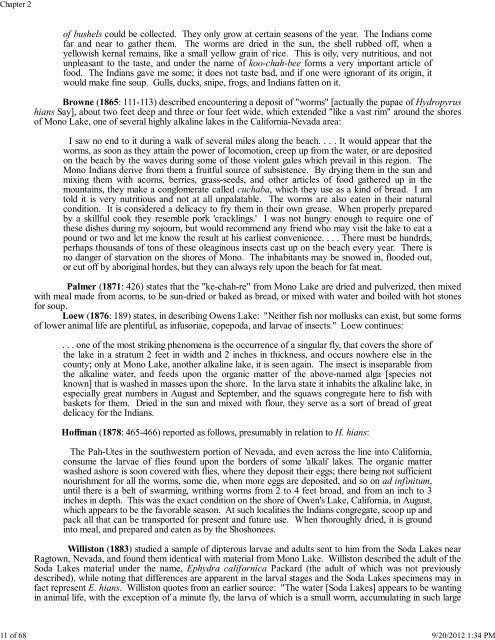Chapter 2. Insect Foods of North American Indigenous Populations ...
Chapter 2. Insect Foods of North American Indigenous Populations ...
Chapter 2. Insect Foods of North American Indigenous Populations ...
Create successful ePaper yourself
Turn your PDF publications into a flip-book with our unique Google optimized e-Paper software.
<strong>Chapter</strong> 211 <strong>of</strong> 68 9/20/2012 1:34 PM<strong>of</strong> bushels could be collected. They only grow at certain seasons <strong>of</strong> the year. The Indians comefar and near to gather them. The worms are dried in the sun, the shell rubbed <strong>of</strong>f, when ayellowish kernal remains, like a small yellow grain <strong>of</strong> rice. This is oily, very nutritious, and notunpleasant to the taste, and under the name <strong>of</strong> koo-chah-bee forms a very important article <strong>of</strong>food. The Indians gave me some; it does not taste bad, and if one were ignorant <strong>of</strong> its origin, itwould make fine soup. Gulls, ducks, snipe, frogs, and Indians fatten on it.Browne (1865: 111-113) described encountering a deposit <strong>of</strong> "worms" [actually the pupae <strong>of</strong> Hydropyrushians Say], about two feet deep and three or four feet wide, which extended "like a vast rim" around the shores<strong>of</strong> Mono Lake, one <strong>of</strong> several highly alkaline lakes in the California-Nevada area:I saw no end to it during a walk <strong>of</strong> several miles along the beach. . . . It would appear that theworms, as soon as they attain the power <strong>of</strong> locomotion, creep up from the water, or are depositedon the beach by the waves during some <strong>of</strong> those violent gales which prevail in this region. TheMono Indians derive from them a fruitful source <strong>of</strong> subsistence. By drying them in the sun andmixing them with acorns, berries, grass-seeds, and other articles <strong>of</strong> food gathered up in themountains, they make a conglomerate called cuchaba, which they use as a kind <strong>of</strong> bread. I amtold it is very nutritious and not at all unpalatable. The worms are also eaten in their naturalcondition. It is considered a delicacy to fry them in their own grease. When properly preparedby a skillful cook they resemble pork 'cracklings.' I was not hungry enough to require one <strong>of</strong>these dishes during my sojourn, but would recommend any friend who may visit the lake to eat apound or two and let me know the result at his earliest convenience. . . . There must be hundrds,perhaps thousands <strong>of</strong> tons <strong>of</strong> these oleaginous insects cast up on the beach every year. There isno danger <strong>of</strong> starvation on the shores <strong>of</strong> Mono. The inhabitants may be snowed in, flooded out,or cut <strong>of</strong>f by aboriginal hordes, but they can always rely upon the beach for fat meat.Palmer (1871: 426) states that the "ke-chah-re" from Mono Lake are dried and pulverized, then mixedwith meal made from acorns, to be sun-dried or baked as bread, or mixed with water and boiled with hot stonesfor soup.Loew (1876: 189) states, in describing Owens Lake: "Neither fish nor mollusks can exist, but some forms<strong>of</strong> lower animal life are plentiful, as infusoriae, copepoda, and larvae <strong>of</strong> insects." Loew continues:. . . one <strong>of</strong> the most striking phenomena is the occurrence <strong>of</strong> a singular fly, that covers the shore <strong>of</strong>the lake in a stratum 2 feet in width and 2 inches in thickness, and occurs nowhere else in thecounty; only at Mono Lake, another alkaline lake, it is seen again. The insect is inseparable fromthe alkaline water, and feeds upon the organic matter <strong>of</strong> the above-named alga [species notknown] that is washed in masses upon the shore. In the larva state it inhabits the alkaline lake, inespecially great numbers in August and September, and the squaws congregate here to fish withbaskets for them. Dried in the sun and mixed with flour, they serve as a sort <strong>of</strong> bread <strong>of</strong> greatdelicacy for the Indians.H<strong>of</strong>fman (1878: 465-466) reported as follows, presumably in relation to H. hians:The Pah-Utes in the southwestern portion <strong>of</strong> Nevada, and even across the line into California,consume the larvae <strong>of</strong> flies found upon the borders <strong>of</strong> some 'alkali' lakes. The organic matterwashed ashore is soon covered with flies, where they deposit their eggs; there being not sufficientnourishment for all the worms, some die, when more eggs are deposited, and so on ad infinitum,until there is a belt <strong>of</strong> swarming, writhing worms from 2 to 4 feet broad, and from an inch to 3inches in depth. This was the exact condition on the shore <strong>of</strong> Owen's Lake, California, in August,which appears to be the favorable season. At such localities the Indians congregate, scoop up andpack all that can be transported for present and future use. When thoroughly dried, it is groundinto meal, and prepared and eaten as by the Shoshonees.Williston (1883) studied a sample <strong>of</strong> dipterous larvae and adults sent to him from the Soda Lakes nearRagtown, Nevada, and found them identical with material from Mono Lake. Williston described the adult <strong>of</strong> theSoda Lakes material under the name, Ephydra californica Packard (the adult <strong>of</strong> which was not previouslydescribed), while noting that differences are apparent in the larval stages and the Soda Lakes specimens may infact represent E. hians. Williston quotes from an earlier source: "The water [Soda Lakes] appears to be wantingin animal life, with the exception <strong>of</strong> a minute fly, the larva <strong>of</strong> which is a small worm, accumulating in such large
















